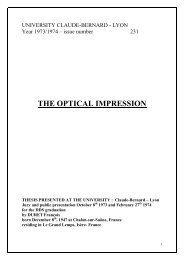english version(pg40to78) - Pr. François Duret
english version(pg40to78) - Pr. François Duret
english version(pg40to78) - Pr. François Duret
You also want an ePaper? Increase the reach of your titles
YUMPU automatically turns print PDFs into web optimized ePapers that Google loves.
F <strong>Duret</strong> and Coll. <strong>Pr</strong>incipes de fonctionnement et applications techniques de l’empreinte optique dans l’exercice de cabinet<br />
(traduction Anglaise)<br />
Page 106<br />
What’s left to do is let them do the entire realisation of the biomaterial<br />
until its final phase and the ulterior treatments necessary to the<br />
adaptation of the pre shape of the substance loss don’t perturb the<br />
acquired properties. We think that we need to radically change<br />
direction, give up on technical prowess due to the material’s<br />
exploitation mode and unjustly penalised by the financial fees they<br />
entail.<br />
Our objectives<br />
After having created a prosthetic volume just and precise by optical<br />
reading:<br />
- manufacture a material whose bioproperties will be closest to<br />
those of the destroyed tissue. This material will exist in the pre<br />
shapes with general properties stables and defined in the<br />
specifications<br />
- convert the prosthetic volume memorised by manufacturing the<br />
biomaterial pre shape<br />
- establish solid and durable links between the organ and the<br />
prosthetic volume manufactured in the chosen biomaterial.<br />
In the “unitary” dental biomaterial context, three values have to be<br />
studied and put together:<br />
- the prosthetic material<br />
- the linking agent<br />
- the receiving organ, that is to say for a unitary reconstitution, the<br />
dentin and dental enamel.<br />
The prosthetic material<br />
For the unitary biomaterial, six property categories have been isolated<br />
with regards to the concerned clinical requirements:<br />
<strong>Pr</strong>operties: physical, mechanical, chemical, optical, biological and<br />
technological.<br />
The first four properties are to be put together with those of enamel<br />
and dentin. The biological properties will limit or modify the previous<br />
properties to make the biomaterial compatible with the concerned<br />
tissues. Finally the technological requirements (manufacturing needs)<br />
Les Cahiers de <strong>Pr</strong>othèse (50) pp 73 – 110, 1985



